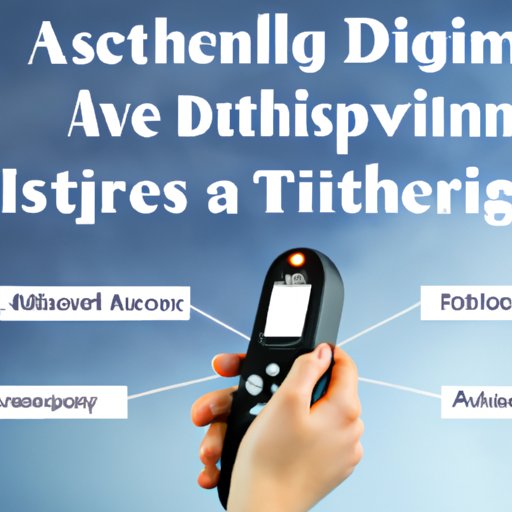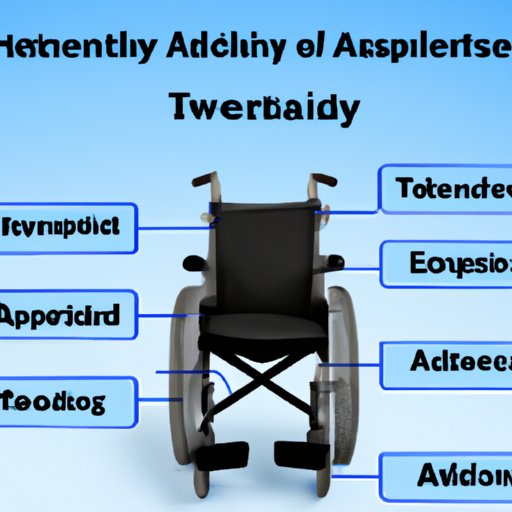Introduction
Assistive technology (AT) is any device, piece of equipment, software program, or product system that is used to increase, maintain, or improve the functional capabilities of individuals with disabilities. AT can range from a simple magnifying glass to complex computer systems and is designed to help people with disabilities gain independence, improve their quality of life, and participate more fully in society.

Exploring the Different Types of Assistive Technology and Their Benefits
There are many different types of assistive technology available, each designed to meet specific needs. Some of the most common types of AT include physical aids, communication aids, and computer accessibility.
Physical Aids
Physical aids are designed to help people with physical disabilities manage everyday tasks. Examples of physical aids include wheelchairs, canes, walkers, prosthetics, and adaptive seating. These devices can help improve mobility and give people with physical disabilities greater independence.
Communication Aids
Communication aids are designed to help people with speech or hearing impairments communicate more effectively. Examples of communication aids include hearing aids, voice amplifiers, and sign language interpreters. These devices can help people with speech or hearing impairments feel more included in conversations and engage in activities they may otherwise be unable to participate in.
Computer Accessibility
Computer accessibility aids are designed to help people with physical, sensory, or cognitive disabilities use computers and other electronic devices. Examples of computer accessibility aids include screen readers, Braille displays, and speech recognition software. These devices can help people with disabilities access information and participate in activities they may not be able to do without the aid of technology.

Examining the Uses of Assistive Technology to Improve Quality of Life
Assistive technology can help improve the quality of life for people with disabilities in many ways. The following are some of the most common uses of AT.
Mobility
Assistive technology can help people with physical disabilities move around more easily. Mobility aids such as wheelchairs, scooters, and canes can help people with disabilities get around independently and safely. According to a study published in the Journal of Physical Therapy Science, the use of assistive technology can “greatly improve the quality of life for people with mobility impairments.”
Independence
Assistive technology can also help people with disabilities become more independent. For example, communication aids can help people with speech or hearing impairments communicate more effectively, while computer accessibility aids can help people with physical, sensory, or cognitive disabilities access information and participate in activities they may not be able to do without the aid of technology.
Health and Safety
Assistive technology can also help people with disabilities stay safe and healthy. For example, adapted kitchen appliances and adaptive eating utensils can help people with physical disabilities prepare meals safely, while medical alert systems and emergency response systems can help people with disabilities stay safe in an emergency situation.
Understanding How Assistive Technology Can Help People with Disabilities
Assistive technology can help people with disabilities in many ways. The following are some of the most common benefits of AT.
Improved Accessibility
Assistive technology can help make public places and services more accessible for people with disabilities. For example, AT can help provide wheelchair access to buildings, transportation services, and recreational facilities. This can help people with disabilities participate in activities they may not be able to do without the aid of technology.
Increased Opportunities
Assistive technology can also help people with disabilities take advantage of educational and employment opportunities. For example, AT can help people with disabilities access online courses and job-training programs, which can help them gain the skills and experience necessary to pursue a career.
Empowerment
Assistive technology can also help people with disabilities feel empowered. By using AT, people with disabilities can gain greater independence and control over their lives, which can lead to increased self-esteem and confidence.
Investigating the Cost of Assistive Technology and Potential Funding Sources
The cost of assistive technology can vary widely depending on the type and complexity of the device. In addition, the cost of maintaining and repairing AT can add up quickly. Fortunately, there are a few potential funding sources that can help offset the cost of AT.
Costs and Benefits
When considering the cost of assistive technology, it is important to weigh the costs against the benefits. While the initial cost of AT can be expensive, the long-term benefits can far outweigh the cost. For example, the use of AT can help people with disabilities become more independent, leading to improved quality of life and greater opportunities for success.
Financial Assistance Programs
There are a number of financial assistance programs available to help people with disabilities cover the cost of assistive technology. The U.S. Department of Education’s Office of Special Education and Rehabilitative Services provides grants to states to help fund AT programs. In addition, many states and local organizations offer grants and loan programs to help people with disabilities purchase AT.
Other Funding Sources
In addition to financial assistance programs, there are a number of other potential funding sources for AT. Organizations such as Easter Seals and United Way often provide grants or loans to help people with disabilities purchase AT. Insurance plans may also cover the cost of certain types of AT, so it is important to check with your insurance provider to see if you are eligible for coverage.

An Overview of Assistive Technology and Its Role in Education
Assistive technology can play an important role in education by helping students with disabilities access curriculum and participate in classroom activities. AT can also help create equal opportunity by providing students with disabilities the same resources and tools as their peers.
Adapting Curriculum
Assistive technology can help teachers adapt the curriculum to meet the needs of students with disabilities. For example, AT can help provide students with visual impairments access to textbooks and course materials in Braille or audio formats. AT can also help provide students with physical disabilities access to specialized computer hardware and software.
Creating Equal Opportunity
Assistive technology can also help create equal opportunity in the classroom by providing students with disabilities the same resources and tools as their peers. For example, AT can help provide students with physical disabilities access to the same technology that their classmates use, allowing them to participate in activities equally.
Enhancing Learning
Assistive technology can also help enhance learning for students with disabilities. For example, AT can help provide students with hearing impairments access to real-time captioning or sign language interpreters, allowing them to better understand and engage in classroom discussions. AT can also help provide students with physical disabilities access to modified keyboards or voice recognition software, making it easier for them to complete assignments.

The Impact of Assistive Technology on Employment Opportunities
Assistive technology can also help people with disabilities find and maintain employment. AT can help provide job training and support services, as well as workplace accommodations.
Job Training
Assistive technology can help provide job training for people with disabilities. For example, AT can help provide people with physical disabilities access to job-training programs and career counseling services. AT can also help provide people with cognitive disabilities access to job-readiness programs and other resources to help them prepare for employment.
Employment Support Services
Assistive technology can also help provide employment support services for people with disabilities. For example, AT can help provide people with hearing impairments access to real-time captioning and sign language interpreters, allowing them to better communicate with coworkers and employers. AT can also help provide people with physical disabilities access to modified workstations or specialized computer hardware, making it easier for them to perform job duties.
Workplace Accommodations
Assistive technology can also help provide workplace accommodations for people with disabilities. For example, AT can help provide people with visual impairments access to enlarged computer monitors or tactile keyboards, allowing them to better access information and perform job duties. AT can also help provide people with physical disabilities access to adapted tools or devices, making it easier for them to perform job tasks.
A Look at How Assistive Technology Enhances Accessibility for People with Disabilities
Assistive technology can play an important role in enhancing accessibility for people with disabilities. AT can help increase inclusion by providing people with disabilities access to public spaces and services, as well as improving accessibility standards by providing people with disabilities access to the same tools and resources as everyone else.
Increasing Inclusion
Assistive technology can help increase inclusion by providing people with disabilities access to public spaces and services. For example, AT can help provide people with physical disabilities access to wheelchair ramps or elevators, allowing them to enter public buildings more easily. AT can also help provide people with hearing impairments access to real-time captioning and sign language interpreters, allowing them to more fully participate in social activities.
Improving Accessibility Standards
Assistive technology can also help improve accessibility standards by providing people with disabilities access to the same tools and resources as everyone else. For example, AT can help provide people with visual impairments access to books and other printed materials in Braille or audio formats, allowing them to access the same information as their peers. AT can also help provide people with cognitive disabilities access to modified computer hardware and software, allowing them to complete tasks more easily.
Reducing Barriers
Assistive technology can also help reduce barriers for people with disabilities. For example, AT can help provide people with hearing impairments access to real-time captioning, allowing them to more easily understand conversations. AT can also help provide people with physical disabilities access to adapted tools or devices, making it easier for them to participate in activities they may not be able to do without the aid of technology.
Conclusion
Assistive technology can play an important role in improving the quality of life for people with disabilities. AT can help provide people with disabilities access to public spaces and services, as well as educational and employment opportunities. In addition, AT can help provide people with disabilities access to the same tools and resources as everyone else, helping to reduce barriers and create equal opportunity. By understanding the purpose of assistive technology and its potential to improve quality of life, we can continue to strive for a more inclusive and accessible world.
Summary
This article explored the purpose of assistive technology and how it can help people with disabilities improve their quality of life. It examined the different types of AT and their benefits, as well as the impact they have on education and employment. It also looked at the cost of AT and potential funding sources, as well as the role AT plays in enhancing accessibility for people with disabilities. Overall, this article highlighted the importance of AT and its ability to help people with disabilities gain independence and participate more fully in society.
Call to Action
If you know someone who could benefit from assistive technology, consider researching the different types of AT and potential funding sources. You can also contact your local Department of Education or disability services organization for more information about AT programs and services. Finally, you can reach out to organizations such as Easter Seals and United Way to learn more about grants and loan programs that can help cover the cost of AT.
(Note: Is this article not meeting your expectations? Do you have knowledge or insights to share? Unlock new opportunities and expand your reach by joining our authors team. Click Registration to join us and share your expertise with our readers.)
